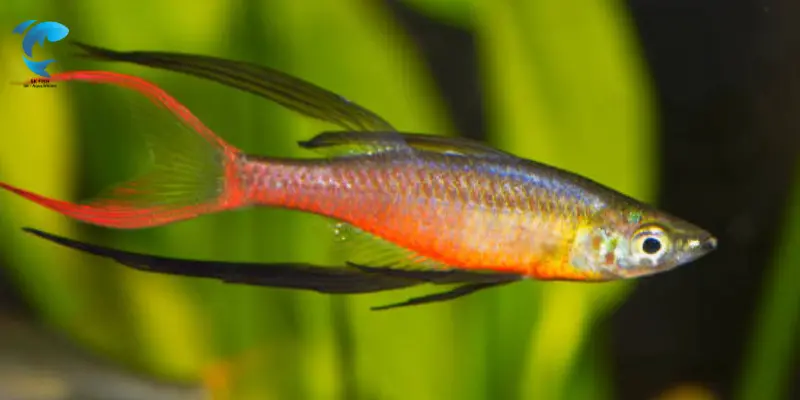How Big Do Rainbowfish Get? A Beginner’s Guide (2025)
Published: 9 Apr 2025
Rainbowfish are among the most colorful and vibrant species to add to your freshwater aquarium. These stunning fish are known for their bright, shimmering scales, which resemble rainbows, making them popular among aquarium enthusiasts. But as with all pet fish, it’s essential to understand their growth and size to ensure they thrive in their environment.
In this article, we will answer how big do rainbowfish get, explore the factors that influence their size, and provide valuable insights on caring for rainbowfish in your aquarium.
Introduction to Rainbowfish
Rainbowfish are a diverse group of species belonging to the family Melanotaeniidae. They are native to Australia, Papua New Guinea, and parts of Indonesia and thrive in freshwater environments such as rivers, lakes, and swamps. Rainbowfish species vary in size, color, and behavior, but they all share the same characteristic: their radiant, multi-colored appearance.

Understanding the size and growth potential of rainbowfish is crucial for aquarium owners. Choosing the right species, setting up an appropriate tank, and providing proper care will help ensure your rainbowfish grow to their full potential and live healthy, happy lives.
This article will explore how big rainbowfish can become, what affects their growth, and how to care for them correctly in your aquarium.
What Are Rainbowfish?
Definition and Classification
Rainbowfish are freshwater fish in the family Melanotaeniidae. There are around 55 species of rainbowfish, each with unique features and environmental needs. These fish are known for their striking colors, which range from metallic blues to vibrant reds, oranges, and yellows.
Rainbow fish are divided into several genera, with some of the most popular being Melanotaenia, Glossolepis, and Iriatherina. Some common rainbowfish species include the Boesemani, Australian, and Murray River rainbowfish.
Natural Habitat and Range
Rainbowfish are found in various habitats, including freshwater rivers, lakes, and swamps. They prefer tropical and subtropical climates and can be found in areas with slow-moving waters and dense vegetation. Many rainbow fish freshwater species are endemic to specific regions, while others have a broader distribution across the Indo-Pacific region.
In the wild, rainbowfish can vary in size depending on the species and environmental factors. Understanding their natural habitat is key to providing them with the ideal living conditions in your aquarium.
Popular Species in Aquariums
Some of the most popular rainbowfish species in home aquariums include:
- Boesemani Rainbowfish: Known for their vibrant blue and orange coloration.
- Australian Rainbowfish: A hardy species that is popular among aquarium hobbyists.
- Murray River Rainbowfish: A slightly larger species native to Australia.
- Threadfin Rainbowfish: A smaller species with delicate fins.
These species are widely available in pet stores and are well-suited for aquariums, provided they are adequately cared for.
Growth and Size Characteristics

Average Size of Rainbowfish Species
Rainbowfish species can vary greatly in size, with some growing as small as 2 inches and others reaching up to 6 inches or more. The average size of rainbowfish depends on the species and environmental factors, such as tank size and water conditions.
For example, Boesemani rainbowfish typically grow to about 4–5 inches long, while Australian rainbowfish can reach up to 6 inches. On the other hand, species like the Threadfin rainbowfish tend to remain smaller, growing to about 2.5 inches.
Factors That Influence Their Growth
Several factors can affect the size of rainbowfish, including:
- Species Variations: Different species of rainbowfish have different growth potentials. For example, Boesemani rainbowfish are known to grow relatively large compared to other species, while species like the Threadfin rainbowfish stay smaller.
- Gender Differences: In some species, males grow larger than females, though the difference is usually minimal.
- Environmental Factors: Rainbowfish’s size can also be influenced by the conditions of their tank. Fish that live in larger tanks tend to grow bigger as they have more space to swim and find food. Proper water conditions, temperature, and diet can also contribute to healthy growth.
Growth Stages from Juvenile to Adult
Rainbowfish grow in several stages throughout their life:
- Juvenile Stage: When rainbowfish are first born, they are tiny, typically just a few millimeters long. During this stage, they are most vulnerable to changes in their environment.
- Adolescent Stage: As rainbowfish mature, they show signs of their characteristic color patterns. Their size increases steadily during this period, eventually reaching their full adult size.
- Adult Stage: Once rainbowfish reach adulthood, their growth slows down. They will maintain a relatively stable size throughout their lives.
Rainbowfish Size by Species
Boesemani Rainbowfish

Boesemani rainbowfish are among the most popular species due to their stunning blue and orange coloration. These fish can grow up to 4–5 inches long. Males are generally larger and more colorful than females, making them a prized choice for aquariums.
Australian Rainbowfish

Australian rainbowfish are one of the largest species, reaching up to 6 inches in length. They are hardy and adapt well to various tank conditions, making them ideal for beginners. Their vibrant colors range from metallic blue to greenish hues.
Murray River Rainbowfish

The Murray River rainbowfish is another species that can grow up to 6 inches long. It is native to Australia and is known for its peaceful nature and beautiful color patterns. This species requires a well-maintained aquarium to thrive.
Other Popular Species
- Threadfin Rainbowfish: Typically grows to about 2.5 inches and has delicate, colorful fins.
- Iriatherina Werneri: Known for its slender body and can grow up to 2 inches.
Factors That Influence Size
Tank Size
The size of the tank plays a significant role in the growth of a rainbow fish aquarium. Larger tanks provide more space for the fish to swim and grow. Rainbowfish are active swimmers, so they need a tank large enough to accommodate their movement. A minimum of a 30-gallon tank is recommended for most rainbowfish species.
Water Conditions
Water temperature, pH, and hardness are critical factors in ensuring the health and growth of rainbowfish. Most species of rainbowfish thrive in temperatures between 75°F and 80°F. The pH should range from 6.5 to 7.5, and the water should be soft to moderately hard. Maintaining these water conditions will encourage healthy growth and vibrant colors.
Diet and Nutrition
A balanced diet plays a significant role in rainbowfish’s growth. Please provide them with various foods, including high-quality flakes and pellets and live or frozen foods like brine shrimp or bloodworms. A nutritious diet will promote faster and healthier growth.
Genetics
The genetics of each species of rainbowfish can also impact their maximum size. Fish bred in optimal conditions grow larger and healthier, while those raised in poor conditions may not reach their full potential.
Behavior and Habitat Preferences

Rainbowfish are active swimmers and require a tank with plenty of open space. They enjoy being in groups, so keeping at least six of them together is recommended to ensure they are comfortable and exhibit natural social behaviors. These fish are peaceful and coexist well with other non-aggressive species.
The ideal tank setup for rainbowfish includes the following:
- A spacious aquarium with a minimum of 30 gallons.
- There are plenty of plants and hiding places for them to explore.
- A gentle water filter to maintain clean water.
- Proper water parameters, such as temperature, pH, and hardness.
How to Encourage Healthy Growth
To help your rainbowfish grow to their full potential, follow these tips:
- Provide a well-maintained tank with plenty of swimming space.
- Maintain optimal water conditions by regularly checking temperature, pH, and hardness.
- Offer a varied diet to ensure they get the necessary nutrients.
- Avoid overstocking your tank, as this can lead to stress and stunted growth.
Common Myths About Rainbowfish Size
There are several misconceptions about rainbowfish size:
| All rainbowfish grow to the same size. |
|---|
Fact: Different species of rainbowfish have different growth potentials. Some species, like the Australian rainbowfish, grow more significant than others. |
| Rainbowfish need huge tanks to grow. |
|---|
Fact: While larger tanks provide more space, many rainbowfish species can thrive in a 30-gallon tank. |
Conclusion
Rainbowfish are beautiful and vibrant additions to any freshwater aquarium. Understanding how big they get is crucial for providing the best care and creating an environment where they can thrive. By choosing the right species, maintaining optimal tank conditions, and offering a healthy diet, you can ensure that your rainbowfish grow to their full potential.
FAQs: How big do rainbowfish get
Rainbowfish typically live for about 5 to 8 years, depending on the species and the care they receive. Some species, like the Boesemani rainbowfish, may live longer with optimal care. The lifespan of rainbowfish is significantly influenced by factors such as water quality, diet, and overall aquarium conditions. Regular tank maintenance and providing a stable environment can help maximize their lifespan.
Yes, rainbowfish tend to grow faster and healthier in larger tanks. A bigger tank gives them more space to swim, encouraging their natural behavior and growth. Fish may become stunted and stressed in smaller, overcrowded tanks, limiting their growth potential. A tank of at least 30 gallons is recommended for optimal growth, but larger tanks will support their development even better.
Rainbowfish are social creatures and thrive in schools. Keeping them in groups of at least 6 to 8 individuals helps reduce stress and promotes natural social behaviors. While it may not directly impact their size, a well-maintained school of rainbowfish will be healthier and more active, supporting better growth. A lack of companionship in the tank could lead to stress, potentially affecting their overall health and development.
The maximum size a rainbowfish can reach in captivity depends on the species and the care provided. For example, the Australian rainbowfish can grow up to 6 inches, while Boesemani rainbowfish typically reach around 4–5 inches. In some cases, under ideal conditions, some species may grow slightly more prominent, but most will stay within their species’ standard size range.
Rainbowfish breed when they reach sexual maturity, typically around 1 to 2 years, depending on the species. While they don’t need to reach their full adult size to breed, they should be at least close to their full size to produce healthy offspring. Smaller, younger fish may not have the energy or resources to breed effectively, so it’s best to wait until they’ve grown sufficiently for breeding.
Following these guidelines, you can provide your rainbowfish with the best care and enjoy watching them grow into vibrant, beautiful fish in your aquarium.

SK Fish is your trusted source for practical fish care tips and delicious seafood recipes. Our team is dedicated to providing reliable, well-researched content for fishing enthusiasts and home cooks alike.

- Be Respectful
- Stay Relevant
- Stay Positive
- True Feedback
- Encourage Discussion
- Avoid Spamming
- No Fake News
- Don't Copy-Paste
- No Personal Attacks



- Be Respectful
- Stay Relevant
- Stay Positive
- True Feedback
- Encourage Discussion
- Avoid Spamming
- No Fake News
- Don't Copy-Paste
- No Personal Attacks





